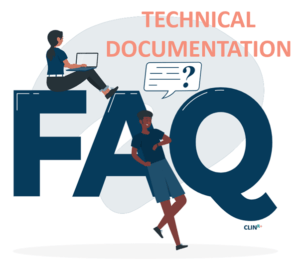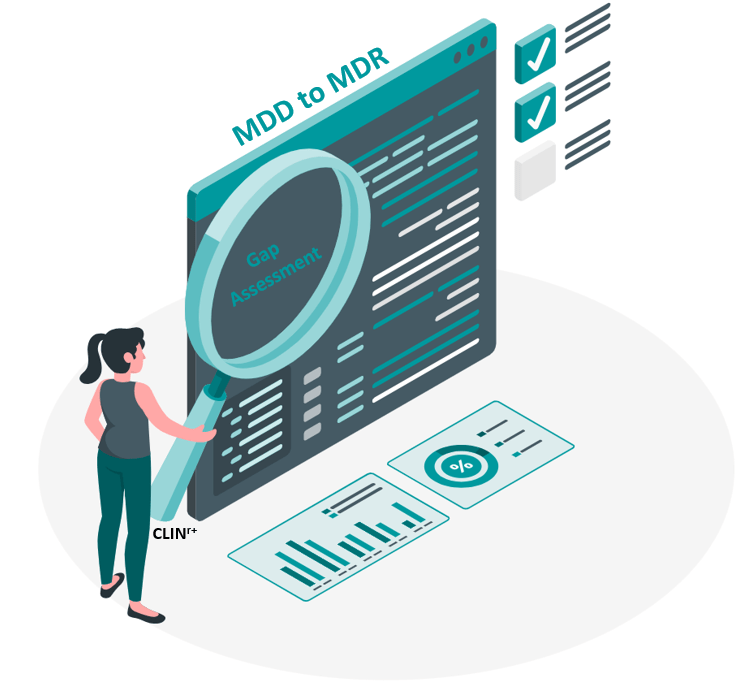Technical Documentation FAQ

Q: What is the preferred source of data for Technical Documentation?
A: The preferred source of data
for Technical Documentation is the manufacturer’s systems. The Technical
Documentation retrieves information from one or several databases and presents
it in human-readable form.
Q:
What are the accepted formats for submitting Technical Documentation?
A: Notified Bodies usually accept Technical Documentation in the following formats:
- PDF (searchable with Optical Character Recognition
applied) - Microsoft Office documents
- XML
Q:
What are the accepted formats for graphical information in the Technical
Documentation?
A: Graphical information in the Technical Documentation can be provided in the following formats:
- JPG, PNG, BMP, GIF, or any other common graphic
file format that can be viewed without specific software. - Constructional and design drawings can be provided
as files. - Videos can be submitted in any common file format
that can be viewed without specific software.
Q: Are
there any guidelines for the structure of the Technical Documentation?
A: Yes, Annex II provides useful guidance for the structure of the Technical Documentation. Bookmarks, links, glossaries, and indexes are recommended to help navigate the Technical Documentation.
Q: Are
there any recommendations for file organization and naming conventions?
A: To ensure ease of use and compatibility with IT infrastructure, it is advised to avoid merging several PDF files into one large PDF or PDF portfolio. Complex folder structures in submissions should be minimized to facilitate searching for evidence and understanding the Technical Documentation. Additionally, long file names should
be avoided as they may affect compatibility with the IT infrastructure.
Q:
What is the recommended approach for protecting and exchanging Technical
Documentation securely?
A: To ensure data security, it is important to provide a password-protected and controlled environment for file submission. This helps to prevent unauthorized access to the Technical Documentation. Sharing files through non-password-protected static links is considered unacceptable in terms of data security.
Q: How
should huge files be shared for Technical Documentation submission?
A: For sharing huge files, it is recommended to use your company’s in-house solution or consult your Notified Body representative for the best method of submitting the Technical Documentation. Email is not suitable for transferring huge file packages.
Ideally, all files should be packed into a single or a small number of downloadable ZIP archives. It is advisable to use a file sharing platform that
allows collective download of these files. Submitting vast numbers of documents as separate downloadable files should be avoided.
Q: Are
there specific tools available to support the e-submission process?
A: Yes, there are various tools available that support the e-submission process, and additional tools are being developed. It is recommended to explore these tools or consult with the Notified Body for guidance on the most suitable options for submitting your Technical Documentation securely.
Q:
What requirements are there for the format of the Technical Documentation to
ensure it is readily searchable?
A: To comply with the overall requirements for a readily searchable Technical Documentation, all information provided in each section, including Section 6, must be in a format that allows searching. For PDF files, Optical Character Recognition (OCR) should be applied to enable text searchability.
Q:
What evidence is required to show that the files provided in the Technical
Documentation are controlled records?
A: The files provided in the Technical Documentation must demonstrate evidence that they are controlled records and have been properly released in the document control system. This can be shown through signatures (handwritten or digital) or other means implemented in your document control system. Files without proof of proper document control will not be acceptable for the conformity assessment report.
Q:
What should be included in the device description section of the Technical
Documentation?
A: The device description section should include the following:
- Device description and specifications
- List of variants, combinations, and model
numbers/names - List of accessories intended to be used with the
device (including those delivered with the device and accessories generally
used to support its intended purpose) - Device-related Basis UDI-DI for each variant
- Device-related nomenclature, such as MD coding and
EMDN (CND) code, to support TÜV SÜD’s assessment of the Technical
Documentation.
Q:
What additional information should be provided in section 1?
A: In this section, you should provide explanations of novel features. These are features that are new in the device compared to the predecessor device or similar devices on the market. If necessary, you can refer to attachments in the Technical Documentation, such as
the justification for the device’s classification (if prepared as a checklist based on Annex VIII).
Q: How
should section 1 of the Technical Documentation be presented?
A: It is important for section 1 of the Technical Documentation to be clear and easily readable since it provides the basic understanding of the device. Therefore, it is recommended to avoid presenting all information solely as attachments. Instead, consider creating a
document that guides the reader (reviewer) through the required elements of the Technical Documentation. This approach will make it easier to read and
understand the information, while minimizing misunderstandings.
Q:
What information should be included in Section 2 of the Technical
Documentation?
A: Section 2 of the Technical Documentation should include the following:
- Labels and instructions given to users and/or
patients. - Information provided by other means.
- Implant card (if applicable).
Q: Are there any language requirements
for labels and instructions?
A: Labels and instructions must be provided in the languages accepted by the Member States where the device is
intended to be sold. However, the MDR does not require medical devices to be placed on the entire EU market right from the start. Manufacturers can choose the markets where the device will be sold and adjust the languages of the Technical Documentation accordingly.
Q: Is it sufficient to provide one set of
information for a medical device variant?
A: No, in the case of several variants of a medical device, it is not sufficient to provide only one exemplary set of information. The complete set of information for all variants must be provided.
Q: What information is required regarding
the design stages of the device?
A: Manufacturers must submit information that allows the design stages applied to the device to be understood. This includes evidence that the device went through design stages and an explanation of any changes made between individual design stages in a manner comprehensible to the reader (reviewer). The information is typically found in a Design History File.
Q: What should be included when
submitting a device developed prior to the MDR that was already on the market
under AIMDD/MDD?
A: When requesting a conformity assessment procedure under the MDR for a device that was already on the market under AIMDD/MDD, manufacturers must include any design iterations performed after the product was initially made available on the market. The Technical Documentation should reflect the current design stage, including all changes made in the past, and provide information for understanding the reasons for any changes made in the post-marketing phase.
Q:
What information and specifications should be included regarding manufacturing
processes?
A: The Technical Documentation must include information and specifications related to manufacturing processes, including the manufacturing procedure with a flow chart and information about used adjuvants. It should also cover quality control measures such as continuous monitoring and final product testing. Manufacturers are required to provide a manufacturing master validation plan, associated summary report, and individual plans and reports for installation qualification (IQ), operational qualification (OQ), and performance qualification (PQ) for non-critical/crucial processes. Plans and reports for critical/crucial processes (e.g., sterilization, packaging) should be provided initially with the Technical Documentation to the Notified Body.
Q:
What is required regarding the identification of sites performing design and
manufacturing activities?
A: Section 3 of the Technical Documentation requires the identification of all sites involved in design and manufacturing activities, including those of suppliers and subcontractors. The Technical Documentation should provide manufacturing information on aspects such as processes and their validation and include a list of suppliers and subcontractors involved in design and manufacturing activities. Manufacturers have sole legal responsibility for their medical devices and must have access to all conformity-related information, including that of suppliers and subcontractors. Information about manufacturing and design activities at suppliers and subcontractors should be provided by the manufacturer directly and cannot be accepted directly from the supplier or subcontractor.
Q:
What information should be included in the Technical Documentation to
demonstrate conformity with the General Safety and Performance Requirements
(GSPRs)?
A: The Technical Documentation should contain information that demonstrates conformity with the GSPRs set out in Annex I of the MDR. This includes providing reasons if a GSPR is considered not applicable, rather than simply identifying it as “n/a” or “not applicable”. Additionally, manufacturers should include the methods used to demonstrate conformity with the applicable GSPRs. These methods can include test plans, standards, common specifications, or other inputs that explain how the manufacturer approaches a specific GSPR. If harmonized standards, common specifications, or other solutions are used, information about these elements should also be included in the Technical Documentation.
Q: How
should evidence of conformity with harmonized standards, common specifications,
or other solutions be presented in the Technical Documentation?
A: To facilitate locating the evidence of conformity with harmonized standards, common specifications, or other solutions, manufacturers should provide the precise identification of the controlled document that offers such evidence and include a cross-reference to the exact location of that evidence in the full Technical Documentation. It is important to provide a clear identifier, pointer, or link to the evidence rather than a general reference to a folder with a large number of documents.
Q: How
can the GSPR-related information be effectively managed?
A: Managing the complexity of GSPR-related information can be challenging. Databases and requirements tracking tools combined with unique information units are emerging as possible solutions for appropriately handling the large amounts of data involved.
Q:
What information should be provided in Section 5 for risk management?
A: Section 5 of Annex II requires the provision of general information on benefit-risk analysis, solutions adopted, and the results of risk management. This section does not introduce new requirements compared to the past, as risk management has always been a crucial aspect of the development, manufacturing, and conformity assessment of medical devices.
Q:
What can be included as solutions risk management?
A: The solutions adopted for risk management can encompass a range of possibilities, including design-related solutions, protective measures, warnings, instructions, functional-safety elements, training, and other measures. These solutions aim to address and mitigate risks associated with the use of medical devices.
Q: Are
there specific requirements for managing medical device risks?
A: Yes, stricter requirements related to the management of risks connected to the use of medical devices are introduced through the General Safety and Performance Requirements (GSPRs). These requirements must be addressed by the documents referenced in Section 5 of the Technical Documentation. Notified Bodies expect to receive information based on requirements according to ISO EN 14971 for risk management plans, reports, clear overall risk benefit statements, as well as other risk management-related information, such as use risks or cybersecurity-related information, as applicable.
Q:
What information should be included in Section 6 of Annex II regarding
verification and validation tests/studies?
A: Section 6 of Annex II requires the documentation to contain the results and a critical analysis of all verification and validation tests and/or studies undertaken to demonstrate conformity with the requirements of the MDR, particularly the applicable General Safety and Performance Requirements (GSPRs). It is important to go beyond mere test reports and provide information that demonstrates overall conformity with the MDR. While a simple list of tests and results is not sufficient, a list or table can be helpful for referencing the information. Novel design features and associated verification, validation, and study results may be of specific interest to the reviewer, so clear referencing to relevant elements addressed in previous sections can enhance understanding.
Q:
What is the definition of pre-clinical and clinical data in Section 6.1?
A: Section 6.1 requires pre-clinical and clinical data to be included in the Technical Documentation. The definition in this section expands beyond pre-clinical data from animal studies and includes detailed information regarding test design, complete test or study protocols, methods, data analysis, data summaries, and test conclusions. This information should cover various aspects, including biocompatibility, physical, chemical, and microbiological characterisation, electrical safety and electromagnetic compatibility, software verification and validation, stability (including shelf life), and performance and safety.
Q:
What should be provided if no new testing has been conducted for a new device
using testing from a predecessor device?
A: If no new testing has been undertaken for a new device because the manufacturer decided to use testing from a predecessor device, the reasons underlying this decision should be explained and supported with documented evidence of the predecessor device in the Technical Documentation.
Q: How
are Sections 6 and 4 related to each other?
A: Sections 6 and 4 of the Technical Documentation are closely related, and there may be some overlap in the information provided on GSPRs and verification and validation. It is important to ensure that the information is clear, unambiguous, and comprehensive across both sections.
Q: Are
there additional special requirements listed in Section 6.2 for specific
devices?
A: Yes, Section 6.2 lists additional special requirements for specific devices, such as devices incorporating medicinal substances, devices utilizing material of human or animal origin, and other specific devices. If there is an available Notified Body assessment report that already covers the assessment of individual elements of an ongoing conformity assessment, a clear reference to that report (by report number) should be provided to facilitate the assessment. It’s important to note that an MDR conformity assessment is a new assessment, and information from previous assessments under the AIMDD/MDD cannot be directly transferred to the MDR assessment.
Gap Assessment
An MDR gap assessment is the process of looking at a medical device’s technical file in a systematic way to determine if it meets all …
Read More →

Supporting an MDD to MDR transition
This case study looks at supporting an MDD to MDR transition and how CLIN-r+ supported one manufacturer when they decided on outsourcing EU MDR to …
Read More →

Supporting an FDA 510k to MDR transition
This case study looks at supporting an FDA 510k to MDR transition and how CLIN-r+ supported one manufacturer’s journey to enter the European market by …
Read More →




